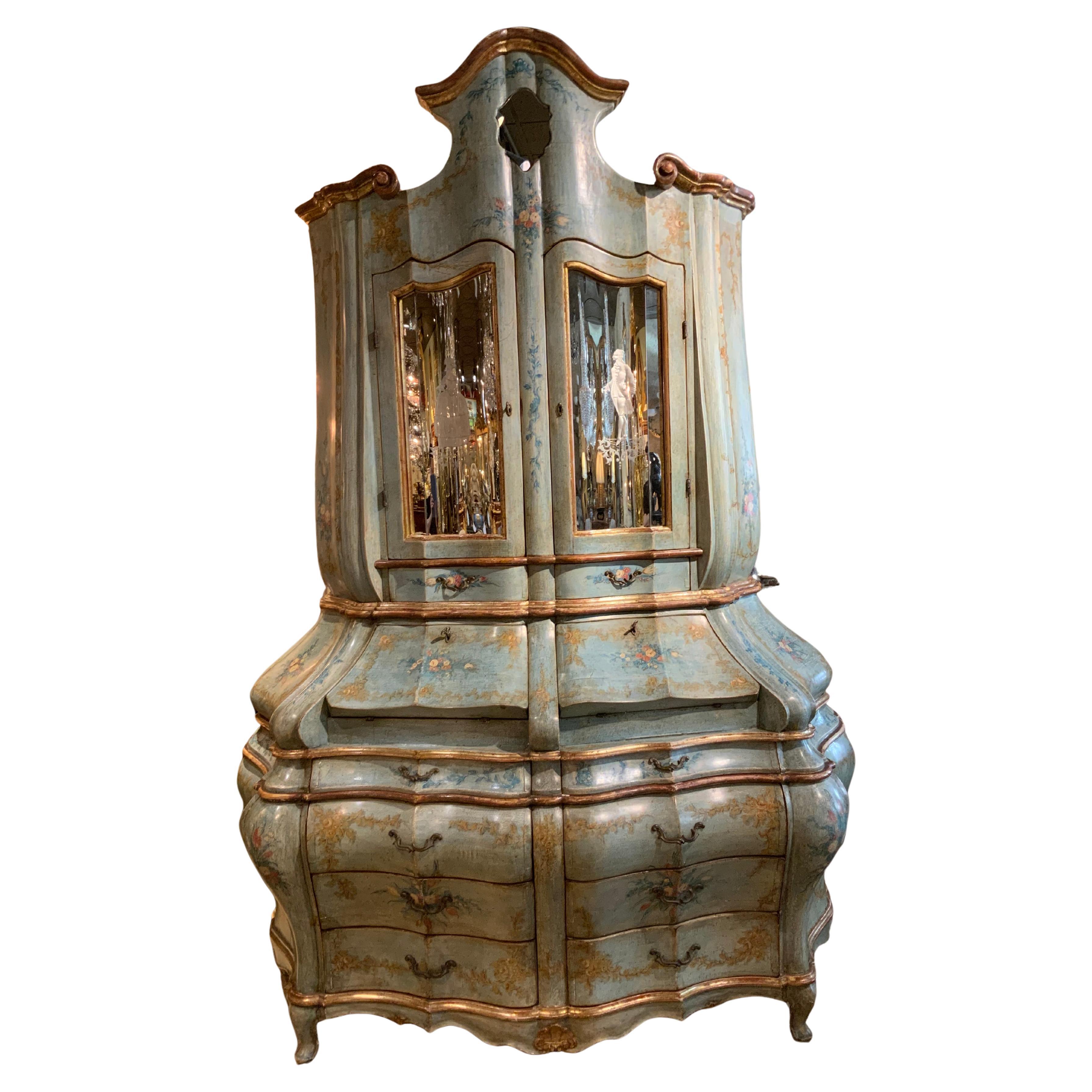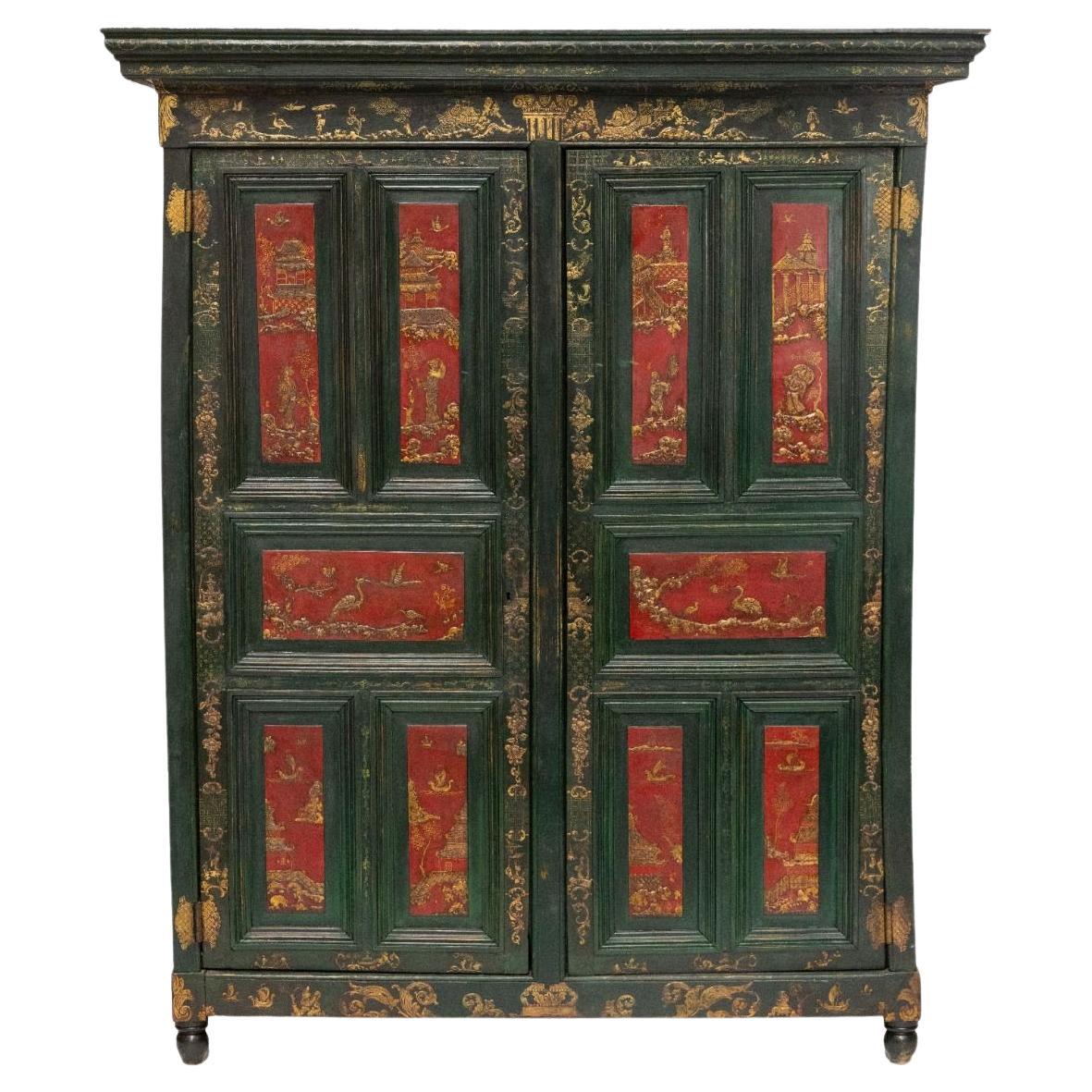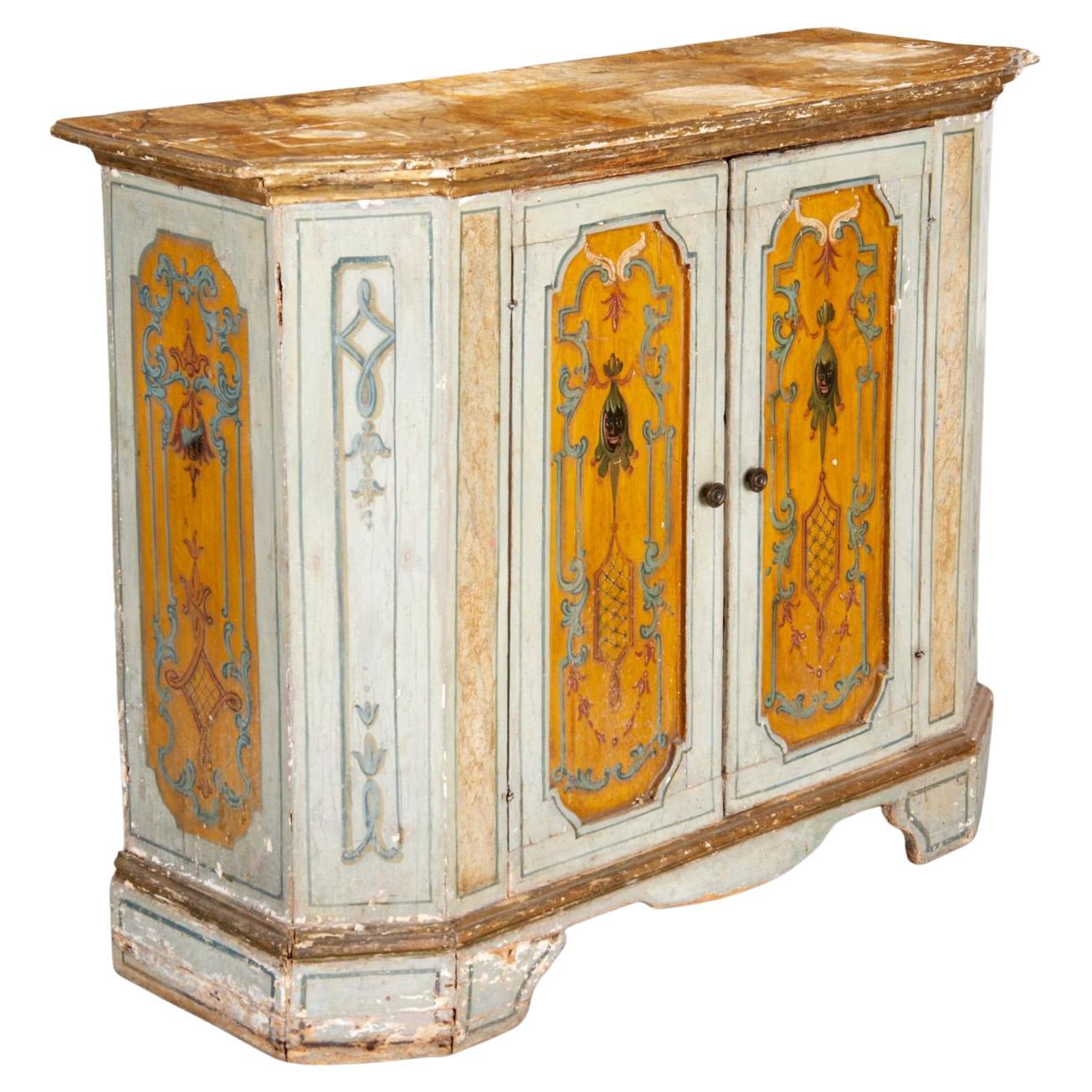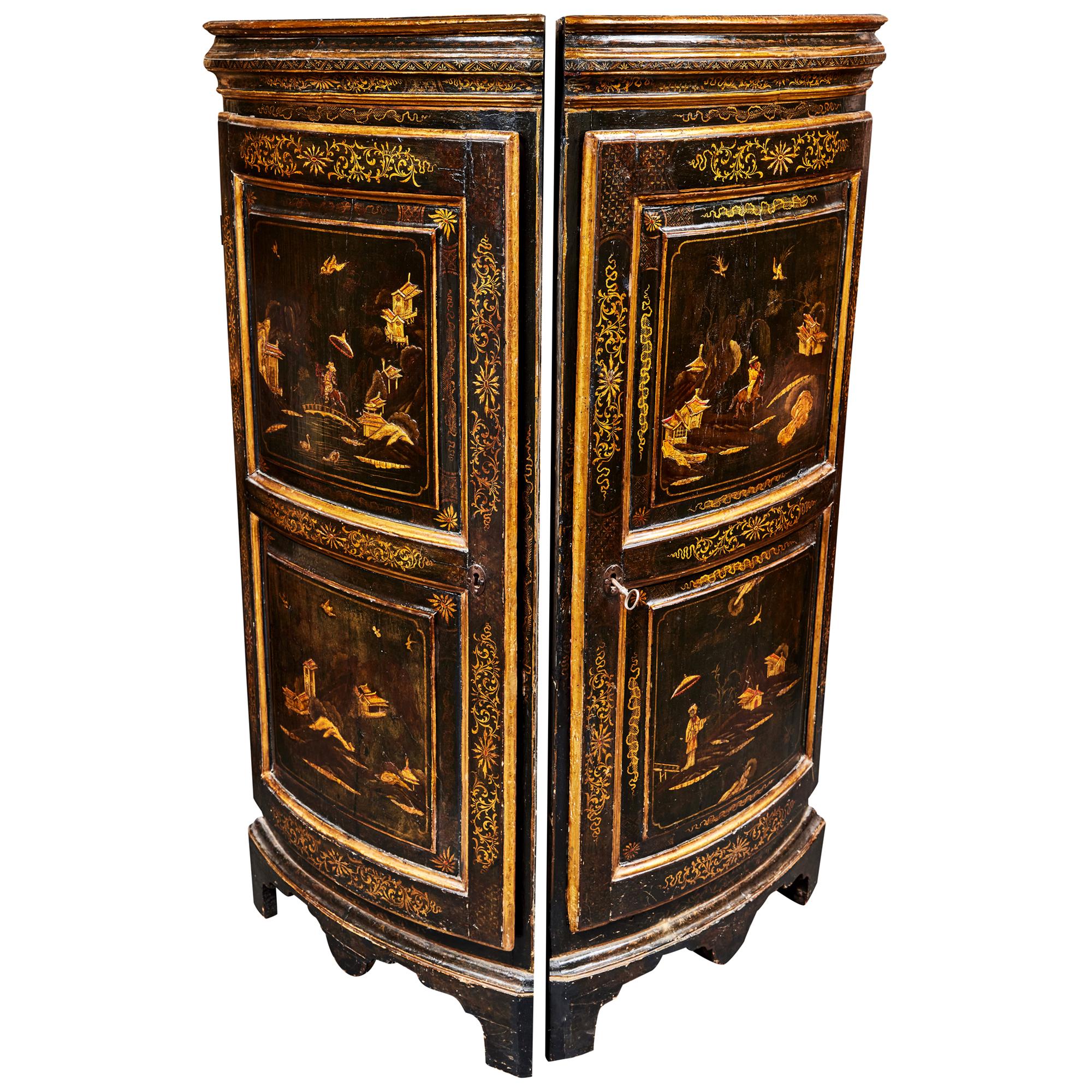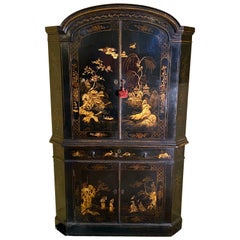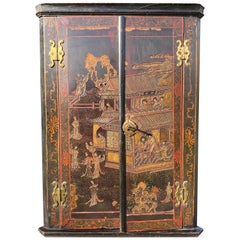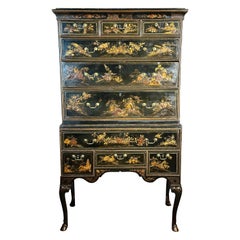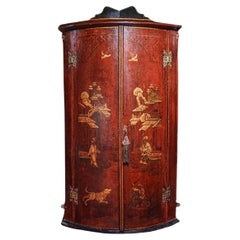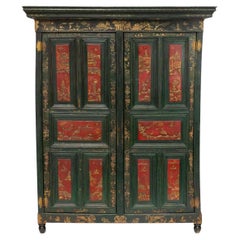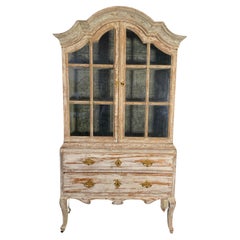Items Similar to 19th Century Venetian Rococo Lacquer Cabinet
Video Loading
Want more images or videos?
Request additional images or videos from the seller
1 of 16
19th Century Venetian Rococo Lacquer Cabinet
$10,446.45
£7,500
€8,868.95
CA$14,220.23
A$15,939.05
CHF 8,299
MX$194,622.64
NOK 105,367.10
SEK 99,878.53
DKK 66,172.01
Shipping
Retrieving quote...The 1stDibs Promise:
Authenticity Guarantee,
Money-Back Guarantee,
24-Hour Cancellation
About the Item
An antique Venetian rococo japanned (or 'lacquer') cabinet.
This rare and sophisticated antique cabinet separates in two, with bombé and serpentine profiles.
The particularly fine and detailed lacquer* is executed on a blue green ground and comprises raised gilt chinoiserie scenes of courtiers, pavilions, rockwork etc.
This bombé and serpentine-combined shape is also seen in German / N. Italian furniture of the mid-18th century. Our piece on offer here is probably a little later, into the 19th century. Despite extensive research we have been unable to locate another comparable example.
*Also known as ‘japanned’.
In excellent condition and of compact dimensions. A chic antique - ready to enhance any interior.
From a private Irish collection.
Measures:
H: 206 cm
D: 43.5 cm
W: 122 cm max.
Literature:
Kreisel, Heinrich, 'Die Kunst des deutschen Möbels. Spätbarock und Rokoko', C. H. Beck, 1970. Note illustrations of similar forms.
References:
See the Victoria and Albert Museum Rococo collections.
- Dimensions:Height: 81.11 in (206 cm)Width: 48.04 in (122 cm)Depth: 17.13 in (43.5 cm)
- Style:Rococo (Of the Period)
- Materials and Techniques:
- Place of Origin:
- Period:
- Date of Manufacture:circa 1750-1760
- Condition:Repaired: A few minor historic repairs to exposed corners where they have been carefully re-attached. Exactly as one would expect, commensurate with its age. Wear consistent with age and use. In excellent condition, lacquer surfaces are stable and intact - ready to enhance any interior.
- Seller Location:Lymington, GB
- Reference Number:Seller: BHA 11981stDibs: LU4081126877452
About the Seller
5.0
Vetted Professional Seller
Every seller passes strict standards for authenticity and reliability
Established in 1957
1stDibs seller since 2018
36 sales on 1stDibs
- ShippingRetrieving quote...Shipping from: Lymington, United Kingdom
- Return Policy
Authenticity Guarantee
In the unlikely event there’s an issue with an item’s authenticity, contact us within 1 year for a full refund. DetailsMoney-Back Guarantee
If your item is not as described, is damaged in transit, or does not arrive, contact us within 7 days for a full refund. Details24-Hour Cancellation
You have a 24-hour grace period in which to reconsider your purchase, with no questions asked.Vetted Professional Sellers
Our world-class sellers must adhere to strict standards for service and quality, maintaining the integrity of our listings.Price-Match Guarantee
If you find that a seller listed the same item for a lower price elsewhere, we’ll match it.Trusted Global Delivery
Our best-in-class carrier network provides specialized shipping options worldwide, including custom delivery.More From This Seller
View AllEarly 18th Century Japanned Double Corner Cabinet
Located in Lymington, GB
A rare chinoiserie standing double corner cabinet, or cupboard.
English, George I-period, ca 1720.
Often erroneously referred to as lacquer work, this is japanned. Beautifully decorated with idyllic scenes of rockwork, pagodas, people, trees, birds, water, with bridges and a boat.
This is a lovely and very useful addition to a room - where corners can present furnishing dilemmas - and this is a chic antique drinks cabinet. These have always been very hard to find, as opposed to the more usual Georgian hanging corner cupboards...
Category
Antique Early 18th Century English George I Cabinets
Materials
Lacquer
Early 18th Century Coromandel Lacquer Corner Cabinet
Located in Lymington, GB
An early-18th century Coromandel lacquer corner cupboard or cabinet.
This is rare - high quality Coromandel lacquer work (incised decoration) - not to be confused with the usual English japanned versions.
This is also referred to as Bantam work, originating in Bantam, Dutch East Indies, and China, for export to the European market.
The subject matter is of a major pavilion with numerous courtiers - most unusual to see only females - it has been suggested that they may be concubines to a Mandarin.
All of high quality and in the sought-after and refined chinoiserie taste.
In very good unrestored state, retaining vibrant colours and all its original hardware. This is a chic antique, and makes a lovely chinoiserie drinks cabinet...
Category
Antique Early 18th Century Asian Cabinets
Materials
Lacquer
Rare Queen Anne Chinoiserie Japanned Chest On Stand
Located in Lymington, GB
A sophisticated Queen Anne-period chinoiserie japanned chest raised on elegant cabriole legs with 'pony foot' carved detailing.
This early-18th century chest on stand demonstrates the charming and highly fashionable English domestic interpretation of oriental scenes of pagodas, rockwork, trees, ornamental bridges, mythical birds, and figures dressed in the oriental manner, holding parasols and cavorting in gardens. All in remarkable condition having survived some three hundred years. Chests on cabriole supports of this form were also very much in fashion in the American colonies during this early Queen Anne-period (1702-1714). Sometimes erroneously referred to as ‘'lacquer''.
The fashion icon Coco Chanel furnished her exquisite Paris apartments largely in the European chinoiserie taste.
References:
V & A Museum, London - The development of English black japanning 1620-1820.
Literature and further reading:
John Stalker and George Parker...
Category
Antique 18th Century English Queen Anne Commodes and Chests of Drawers
Materials
Lacquer
Early-18th Century Red Japanned Corner Cabinet Cupboard
Located in Lymington, GB
An English early-eighteenth century red japanned bow-front corner cupboard, or cabinet, George II-period, circa 1730.
In superb condition throughout.
Retaining its original butterfly hinges, with a period key and working lock.
These are usually encountered with a black background, however when in red these examples of japanning are much sought after. Many were produced domestically, often by talented female members of the family.
Note the charming English interpretations in the decorated surfaces.
An unusual subject can be seen in the base, a hunter on horseback with sword drawn, confronting a mythological beast, probably representing a tiger with mandarins posing amongst stylised pagodas, rooftops and rockwork.
Chinoiserie-decorated surfaces were extremely popular in the early part of the 18th century, almost reaching a craze among the upper classes wishing to demonstrate their fashionable status. There were several revivals of chinoiserie particularly in the first quarter of the 20th century, so caution is advised in one’s collecting. This type of decoration is also sometimes erroneously referred to as ''lacquer’'.
The fashion icon Coco Chanel furnished her exquisite Paris apartments largely in the European chinoiserie taste.
References:
V & A – The development of English black japanning 1620-1820, A History of Japanning in England: Technique & Decoration.
John Stalker and George Parker...
Category
Antique 18th Century English George II Corner Cupboards
Materials
Lacquer
Rare small early-18th century walnut bureau bookcase cabinet
Located in Lymington, GB
A rare, small, English early-18th century walnut bureau bookcase/ cabinet with a moulded swan-neck pediment. Circa 1727-1730. On the cusp of George I- into George II-period.
The bev...
Category
Antique 18th Century English George I Bookcases
Materials
Walnut
18th Century Mahogany Secretaire Bookcase China Cabinet
Located in Lymington, GB
A fine English mid-18th century mahogany secretaire / secretary / bookcase / china cabinet.
Of lovely, deep, rich color, patina and quality.
George III-period, circa 1760.
The bold, detachable, swan-neck pediment carved with 'Gothic' open fretwork, spiral rosettes and a dentil cornice.
The pediment is centred by a small platform below which is a fluted panel. The bookcase / china cabinet section with two, thirteen-pane glazed doors, with three original adjustable shelves with applied beadings for the display of china etc.
The base with a pull-out writing section fitted with small drawers, two of which have secret releases. These secret drawers are faced with blind-fret 'Gothic' tracery, and centred by a carved, shaped arch.
The base with three cock-beaded drawers, and raised on its original bracket feet which are faced with blind fret.
This fine, sophisticated and well-proportioned example of a secretaire / secretary / cabinet / desk / bookcase is remarkable for having survived in its original state including all swan-neck handles and locks.
Of superb quality, color, patination, and well figured throughout. With mahogany drawer linings: further confirmation of its superlative quality.
Measures:
42" wide (107 cm)
23" deep 58.5 cm)
95" high (241 cm) - without cartouche.
A related antique bureau cabinet...
Category
Antique 1740s English George III Cabinets
Materials
Mahogany
You May Also Like
Venetian rococo 19 th century bureau/secretaire hand painted
Located in Houston, TX
This fine quality Venetian secretary is beautifully carved and finely
Painted in pale teal and rose hues. The bottom is carved in a bombe
Shape and has four drawers that slide easil...
Category
Antique Late 19th Century Italian Secretaires
Materials
Hardwood
French 18th Century Régence Period Chinoiserie Cabinet
Located in Kastrup, DK
Beautiful and decorative cabinet from the French Régence period.
Elegantly adorned with well-preserved chinoiserie designs depicting landscapes, people, birds, and houses in gold lea...
Category
Antique Late 18th Century French Regency Cabinets
Materials
Oak, Pine
19th Century Rococo Cabinet
Located in SE
A rococo cabinet made in Sweden, probably made in Stockholm, about 1770. The secondary color has been removed and left the originally color with ind...
Category
Antique 1770s Swedish Rococo Cabinets
Materials
Pine
$11,773
18th Century Italian Neoclassical Painted and Decorated Cabinet
Located in Bradenton, FL
18th Century Italian Neoclassical Decorated Cabinet is hand-painted and features beautifully rendered neoclassical motifs-garlands, scrolls, urns, and foliate elements. The central d...
Category
Antique 18th Century Italian Neoclassical Cabinets
Materials
Wood
18th Century, Chinoiserie Corner Cabinets
Located in Los Angeles, CA
A pair of elegant, ebonized, lacquered, hand painted and parcel gilt, Chinoiserie decorated corner cabinets. Doors featuring two panels painted with unique scenes and embellished wit...
Category
Antique 1760s Italian Cabinets
Materials
Wood
$27,500 Sale Price / set
50% Off
European Painted Cabinet
Located in Stamford, CT
A continental painted cabinet with an arched top, a door opening to a fitted interior and a lower drawer.
Category
Antique 18th Century and Earlier Unknown Baroque Cabinets
Materials
Giltwood
$3,500
More Ways To Browse
Italian Antique Furniture
Antique Green Cabinet
Antique Blue Cabinet
Gilt Chinoiserie
Blue Green Cabinets
Blue Lacquer Cabinet
Lacquer Cabinet Green
Venetian Cabinet
Antique Kunst
Venetian Rococo Furniture
Japanese Lacquer Cabinets
18th Century Lacquer Cabinets
18th Century German Cabinet
Antique Blue Kitchen Cabinets
18th Century German Rococo
Green Antique Kitchen Cabinets
Japanese Mid Century Cabinets
Antique Compact Cases
